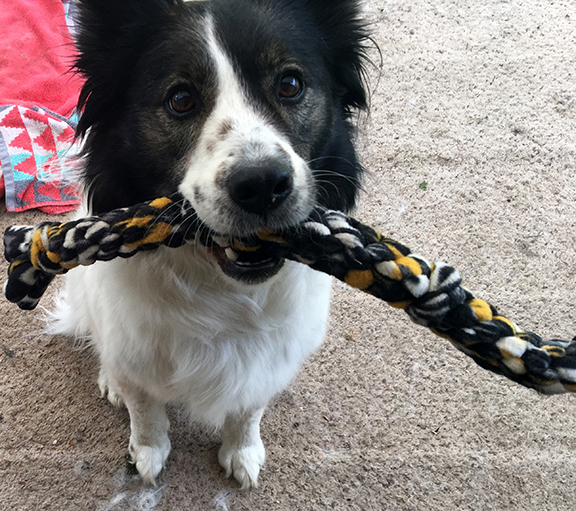I was reminded today how useful the command “Get It” can be when my handy dryer ball bounced off the wall and rolled under the bed while I was doing laundry. Instead of going to get a flashlight, discovering the batteries were almost dead, finding new batteries, replacing them, and then crawling around on the floor to find the dryer ball, I simply pointed under the bed and said “Get It.” Immediately, two of my dogs eagerly competed to retrieve the ball first. That was so much easier and faster!
“Get It” is one of the first cues I teach my dogs, along with its opposite, “Leave It.” When I point to an object and say “Get It,” my dogs know to bring that object to me. It can be anything: remote controls, fallen socks, leashes, junk mail, and more. This skill proved especially helpful when I had an emergency appendectomy and could not bend down for a while after I got home. “Get It” allowed my dogs to hand me their food bowls, pick up items I accidentally dropped, and generally made everyday life much easier. While my dogs are not service dogs, teaching “Get It” is something most dogs enjoy. If your dog already loves to play fetch, you are already eighty percent of the way there.
I teach different versions of the retrieve. There is the formal competition-style “Get It,” the fun “fetch” retrieve, and the simple “If I point at it and say ‘Get It,’ bring it to me” retrieve. Dogs understand context very well, so they do not get confused using the same instruction in different situations. “Get It” simply means “Go pick up that item and bring it to me.”
There are many ways to train your dog to retrieve. I use all of them depending on the dog’s needs. To start, hold something in your hand like a ball or toy and say “Get It.” Then give a treat or use a clicker if you are clicker training. When the dog puts their mouth on the toy, reward them with a treat. Once they understand this, place the item on the floor and say “Get It” again. Reward any mouth contact with a treat. This step helps the dog see the item differently because it is no longer in your hand but on the floor. When the dog starts picking the item up consistently, reward them again. Then teach them to bring it close enough so you can take it from them and reward that behavior as well. Once your dog has mastered this, you can begin throwing the item further away to build distance.
When your dog is confident with toys or balls, try introducing other items that are not toys such as keys, remotes, or pieces of mail. Repeat the training process of rewarding mouth contact and handing over the item. Once your dog understands that “Get It” can refer to many different objects, start putting two items side by side and point to the one you want. When your dog chooses correctly, give lots of praise and treats. You can continue adding more items over time, but make sure to separate the objects so your dog does not get confused about which item to retrieve.
I usually train “get it”, informally. Sometimes I use treats, sometimes just verbal praise like “Good girl, thank you.” This is a wonderful way to involve your dog in everyday tasks. For example, when you are doing laundry and drop a sock, you can ask your dog to “Get It.” Cooking dinner? Drop a spoon and ask your dog to “Get It.” If you have children, let your dog help by picking up their toys. Watching television? Use commercial breaks as short training sessions by “accidentally” dropping pens, notepads, mail, or the remote and asking your dog to “Get It.” This way, you get several minutes of fun, easy training each day.
Using “Get It” frequently around your home encourages your dog to stay close and pay attention to you. Your dog learns to expect fun and rewards while helping out with daily activities. This builds a stronger bond and gives your dog a great way to spend the day with you.

